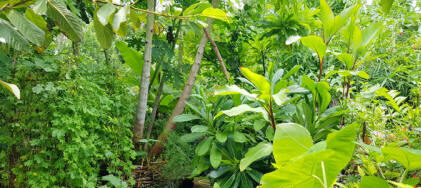
New Research on Agnihotra and Photosynthesis January/February 2024 Satsang | Volume 51 #6 | New Era 81
Table of Contents
New Research on Agnihotra and Photosynthesis
Homa Therapy Foundation Poland Update
New Research on Agnihotra and Photosynthesis
Ed.
A research article titled, “Comparative Evaluation of Dynamic Photosynthetic
Performance of Plants by Chlorophyll Fluorescence related Parameters in and outside of Agnihotra Atmosphere” has been published in the International Journal of Plant and Environment [9(4), 333-342, published: 28/12/2023.] Download the pdf of the full article here.
The research was conducted by Harshita Singh, Shashi B. Agrawal, and Madhoolika Agrawal, all of the Laboratory of Air Pollution and Global Climate Change, Department of Botany, Institute of Science, Banaras Hindu University, Varanasi, India, and Dr. Ulrich Berk of Deutsche Gesellschaft für Homa-Therapie, Mühlingen, Germany.
Following are some excerpts from the report:
“Agnihotra is a Vedic method to purify the atmosphere and the whole environment and bring Nature back to Harmony. It is the simplest and basic Yajnya tuned to the biorhythm of sunrise and sunset. This study has evaluated the physiological performance of 14 plants (11 trees, 1 shrub, and 2 crops) that are present in a place where Agnihotra has been regularly performed to that of a place where it is not performed. Both places had regular anthropogenic interferences. It is inferred that the Agnihotra atmosphere contributed positively to the morphological development (leaf area) and physiology (chlorophyll a fluorescence-related parameters) of the studied plants.
“…it is an obvious hypothesis that plants in an environment where Agnihotra is regularly performed suffer less from pollution-induced stress than those in an environment
where Agnihotra is not performed. This hypothesis was tested by comparing the plants growing in a place where Agnihotra healing fires have been performed for 22 years and on the
same plants some kilometers away with non-Agnihotra but otherwise comparable conditions. For such a test there is a need for diagnostic instruments to gauge the vitality of plants
and especially of trees. Tree vitality is evaluated using analytical
techniques and a visual assessment of leaf senescence.
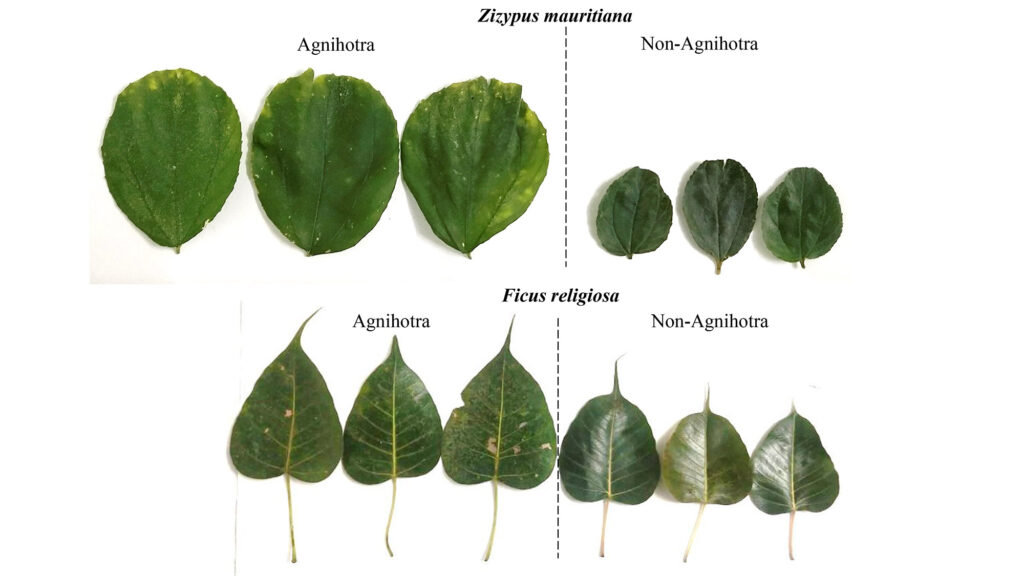

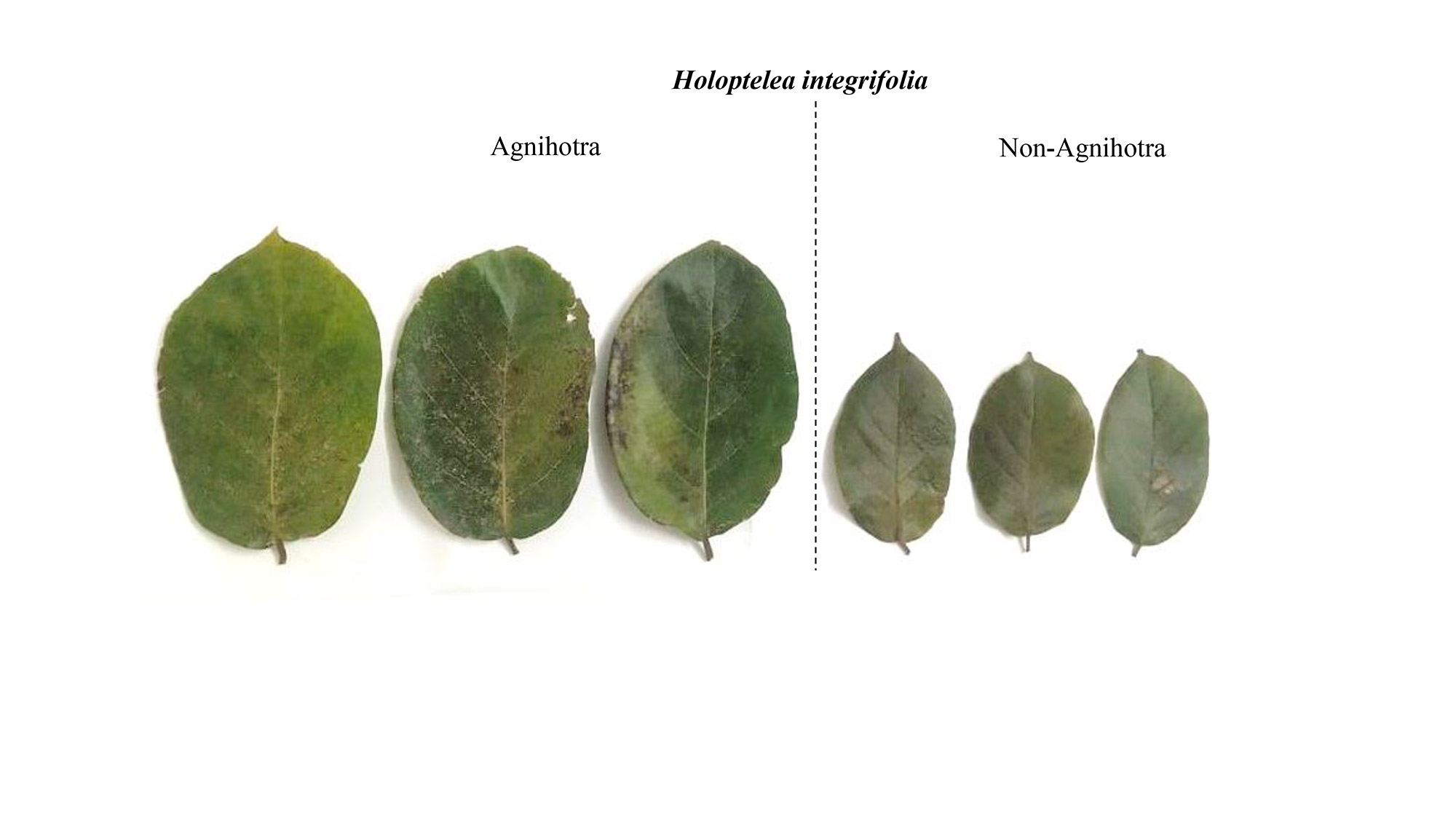
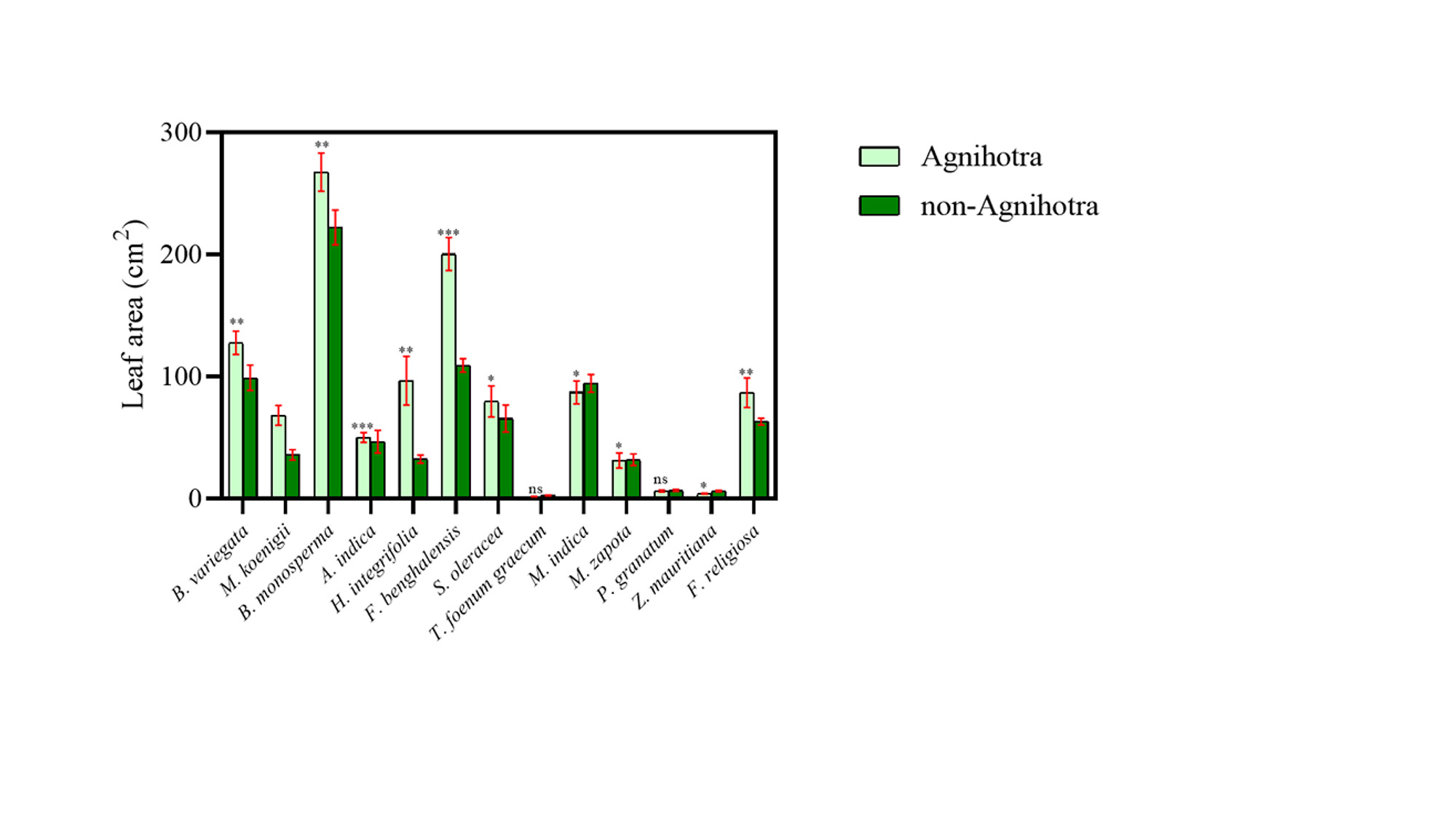 “…Conclusion
“…Conclusion
The study focuses on the effect of the Agnihotra atmosphere on the dynamic photosynthetic performance of the vegetation by comparing the same aspects of the vegetation of a nearby
area… Based on our analysis, we conclude that the Agnihotra atmosphere improves the efficiency of PSII1 by reducing its damage and assisting the repair and protective
processes. The Agnihotra has a significantly positive impact on the photochemical efficiency and morphology of the vegetation. It was also observed that the plants in the Agnihotra atmosphere had a greater number of active reaction centers. They also had significantly higher leaf area which is a demarcation of low pollutant load in the ambience.”
Satsang congratulates the research team for this valuable work in demonstrating the beneficial effects of Agnihotra on plant life.
1 PSII is one of the four major protein complexes in photosynthesis.
Homa Therapy Foundation Poland Update
Ed.
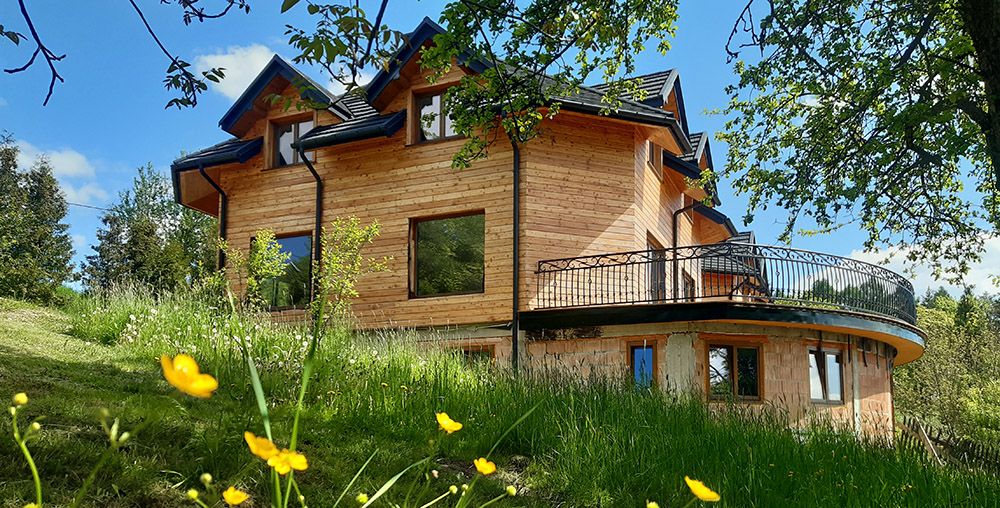
Click here to see a beautiful new film from Homa Therapy Foundation Poland.
Construction of Centre of Light continues to progress. If you feel inspired to help manifest this project, you can donate here.
If you are from the US and would like a tax deduction:
Please donate through Fivefold Path Inc and choose Centre of Light, Poland project.
For more information, please visit:
www.agnihotra.pl
www.homatherapypoland.org
Facebook – Ecovillage Bhrugu Aranya
Agnihotra Polska
Homa Therapy–A Clinical Psychologist’s Perspective
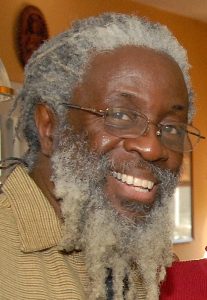
Dr. Henry Gregory
Baltimore, Maryland, USA
(Henry Gregory, PhD. is a clinical psychologist with over 45 years of experience as a trainer, consultant, therapist and author in a number of mental health-related areas, including Substance Abuse Treatment. He served as an assistant professor at the University of Maryland, School of Nursing, the Clinical Director for several agencies in Baltimore and Washington, DC and he maintains a private practice. He is also the president of the Baltimore Homa Community, LLC.-Ed.)
“Under the constant agitation of the senses the mind is just like constantly churning water. You have to gain the capacity to stop the mind. To do this you have to be able to switch the senses off. When this happens the mind does something that it has never done – it goes still. When it goes still it begins to perceive in a different way.”–Vasant Paranjpe
Homa Therapy is the process and practice of training the mind using meditation, mindfulness, values clarification, affirmation, and behavioral skills in an atmosphere seeded with Homa. Homa reduces pollution and consequently reduces stress and tension on the mind. When the stress on the mind is reduced and we become more relaxed, it becomes possible to dive deeper into the mind.
Homas were introduced in the Vedic science of bioenergy. Homa cleanses the environment (air, water, soil, etc.) of the many pollutants that sap human energy by creating blockages to the flow of life energy also known as Prana, chi or ntu, depending on the culture of reference. These pollutants have become a major source of stress and thereby, dysfunction and illness, as the world has become more industrialized. Pollutants overstimulate and tax our immune systems and limit the natural flow of mental, emotional, physical energy that is required for optimal human functioning. In today’s world, it’s as if we live in a dirty fishbowl absorbing endless toxicity without critical consciousness of the effect it has on us.
The Vedic science of bioenergy offers Homas as a calming, nurturing process that feeds nutrients back into the atmosphere, supporting higher mental functioning, resilience, and actualization of potential. There are individuals and communities around the world that have consistently practiced these Homas for the last fifty years.
In Baltimore, Maryland, one of the primary foci of Homa Therapy has been mental health. At one point there existed an agency staffed completely by clinicians and administrators who were Homa practitioners. The agency, The Baltimore Family Life Center, provided therapeutic foster care and behavioral health services as well as professional mental health training for many years, and facilitated the development of many offspring agencies.
Much of the personal and collective turmoil in the world is the result of the negative, dysfunctional programming that occurs as a result of a systemic focus on the acquisition of wealth and power, that exploits rather than supports human needs. As a result, many people feel unattended to and uncared for. Whether they are conscious of these feelings or not, people act out these feelings of hurt, anger, isolation, etc. in many unhealthy ways. The current system that dominates the world seems to only exacerbate the problem, marketing to the vulnerabilities and weaknesses of the populations. The result is a tremendous increase in anxiety (future focus) and depression (past focus) that compromises the wellbeing and happiness of the population. While medications may help this situation in some limited ways, they are not the answer. Yes, they can raise or settle one’s energy in the short term, but what is required is a shift in one’s thinking, emotional regulation and ultimately behaviors.
The common pattern is to get some quick relief without paying attention to long term consequences. So, addictions plague us as a society. When I say addictions, I don’t mean just drugs and alcohol. I also mean addictions to poor eating habits, emotional reactivity, blaming, gambling, smoking, complaining, avoiding discomfort, overthinking, etc. We are creatures of habits. The only question is whether we intentionally choose habits that are healthy for us (or are chosen by habits that are unhealthy for us).
Homa Therapy identifies six desires or passions that sabotage human happiness as the underlying causes of distress that must be accepted into awareness, managed and attended to with some manner of self-discipline (tapa). The passions are: Anger, Lust, Greed, Pride, Envy and Attachment.
Homa Therapy supports health by having the client and provider’s interaction guided by the Seven Rules of Thumb in a nonpathological approach:
- No Fault-finding: positivity (competence, coherency, harmony); compassion, empathy, forgiveness
- Single-pointedness: focus; concentration; present orientation; avoidance of distractions
- Discrimination: freedom of choice; clarification of goals and objectives; finding purpose; follow through (commitment & persistence); conscious consuming
- Non-Attachment: letting go; focus on process (not outcomes/results); acceptance; faith; courage
- Think Something Good
- Say something Good
- Do Something Good
So, in essence Homa Therapy looks to identify, promote and reinforce the client’s innate strengths and competence, thereby assisting the client in understanding his/her/their purpose that may be facilitated and/or masked by addictions, abuse, neglect, etc. at an individual, familial or community level. Addictions at their source are futile efforts to feel good. Abuse, neglect and other traumas create unpleasant feelings that we frequently run from. However, one can run but one cannot hide, as each experience, pleasant or unpleasant, embodies a life lesson that will follow one until and unless one faces the experience and learns the lesson. Homa Therapy promotes a gentle and supportive approach to facing oneself, processing the lessons and changing the behavior. It starts with the premise that each of us has what we need to heal, grow and actualize potential, inside of ourselves. The Homa Therapist’s responsibility is to lead the participant on a journey of self-discovery that uncovers growth-oriented meaning of one’s experiences while acknowledging one’s assets, competencies, capabilities, etc.
Homa Therapy can manifest at three levels of intervention.
- Therapy provided by a practitioner of Agnihotra and the Fivefold Path.
- Therapy provided by a practitioner of Agnihotra/Fivefold Path in an environment infused with Homas. (As a private practitioner, it is not unusual for a client to visit my home office for the first time and express their awe of the “peacefulness” they experience upon entering the residence.)
- Therapy provided by a practitioner of Agnihotra/Fivefold Path in an atmosphere infused with Homas, where the client directly experiences the Homa fire. While benefits are derived at all three levels of intervention, having the client directly participate in the Homas regularly is optimal.
As one client with a long history of childhood trauma, substance abuse, and incarceration shared recently after experiencing Homa Therapy (via the therapist’s regular practice of Agnihotra/Fivefold Path): “This has been great. I really feel like I’ve been freed from my past. You have given me the tools and a process to get over my stuff! Your approach was natural, coming from the inner man, letting the process work for me.” Homa Therapy shapes the energy that the practitioner brings to the interaction, facilitating a more authentic interaction.
Homa practice calms the nervous system, which is generally what is being futilely pursued through substance addictions. Homa helps the client to settle internally so emotional management and regulation become more possible. In a time when anxiety and depression are running rampant all over the planet and being acted out in so many destructive and harmful ways, Homa Therapy offers participants the opportunity to go deeper into their own minds and access deeper brain wave frequencies (Alpha & Theta) which facilitate rest, rejuvenation and connection. Once off the surface of experience that is dominated by sensory overload, one can shift perspective to a less temporal view of life and experience THAT which is more enduring, limitless, and empowering. Homa Therapy facilitates the healing process by introducing the participant to a deeper, more enduring version of oneself.
Client: “I finally feel free and redeemed! I love me some me now!”
In today’s overstimulated world, many of us live on the surface of our minds. Stillness is required to access the depth of our minds where the healthiest parts of oneself reside. Homa provides the opportunity to experience deeper understanding, and connection with self and others. This is the experience for both the Homa Therapist and the client participant, as it is a parallel process. Ultimately, we are all energy. Homa Therapy helps us to access our purist energy states and thereby manifest our highest potential.
For years we have started group therapy sessions with a Homa, so participants would feel more relaxed and access deeper levels of emotional awareness and regulation. During the COVID epidemic, our monthly men’s groups were held virtually. While we always started the session with a Homa fire when in person, I had not planned on doing one virtually, but the men asked for it. They say it helps them feel calmer and more open to experiencing and sharing their emotions and connecting with others even virtually. Homa helps create a safe environment for approaching uncomfortable issues.
Homa Therapy Experiences
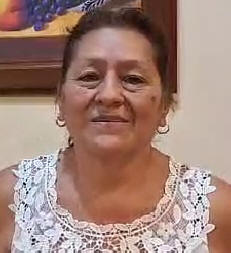 Veronica Sandoval
Veronica Sandoval
Piura, Peru, South America
I am going to be 60 years old. I am diabetic and I had a wound on the sole of my left foot called “chicken eye” but I had not noticed it. It itched and I scratched it. When I looked at it, it was already infected, and when I stepped on it, it hurt. I had this wound for over one week.
I have a sister who practices Agnihotra; she offered me this Agnihotra ash to take and also explained to me how to place it on the wound. So, I did it. And in less than 3 days, the wound was closed and dried up. I was so very much surprised! I am here today participating in Agnihotra because of this experience.
Also, I came with a heaviness and dizziness in my head and now, after the practice, I feel relieved.
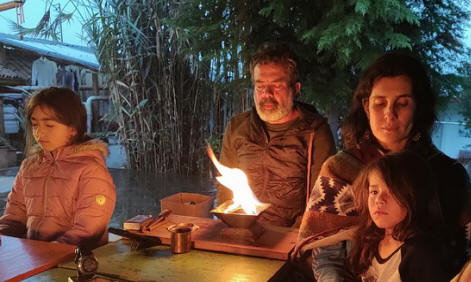 Martin Montes
Martin Montes
Homa Farm
Tenjo, Colombia
South America
Arriving here at the Homa farm was beautiful. The chanting of the Mantras was something very new for me.
I am a very skeptical person about many things. I do not believe very easily. I always had a blockage to belief. I need to see it, feel it, and live it first, in order to realize what something really is.
Because of my work and the rhythm of my day, I worked 18 hours a day; because of the stress and the commitments, I suffered from a very tough gastritis.
When it hit me, not even the medications could help me. It was at some point here at the Homa Farm when I asked myself, “Why am I doing Agnihotra?” And in that immense pain, I took a spoon with Agnihotra ash and put it in my mouth and dissolved it only with saliva, and that took about 5 minutes.
This happened more than 5 years ago. I have been here for almost 6 years and the gastritis never appeared again in my life. So, it is something very healing and I said to myself, “Wow, this really works!”
From that moment on, I also dedicated myself more to the fires. With my children, every time they get the flu, we give them the ash with honey, with lemon, with ginger. It has been very healing.
There is another very beautiful story. I had otosclerosis which runs in my family; we have deaf people. My father was deaf and I went through the same process; my son is going through the same thing. I was ready for surgery, but due to the pandemic, the ear surgery to change the eardrum bone was postponed. Then, at some point I heard the healing story of bringing the ear closer to the heat of the Agnihotra fire. So I started to do that. After the pandemic, I resumed the exams to have the surgery and the doctor told me, “I don’t know what happened to you, but you improved a lot. You are no longer up for surgery. You can use a hearing aid. Maybe it is because of the environment where you live, the vegetation. But you have improved and you are getting better and better.”
(When making Agnihotra ash home remedies, it is recommended to use the best Agnihotra ash. This means using ash from an Agnihotra when:
- one was able to bathe and put on clean clothes before doing Agnihotra
- the exact timing was observed
- the contents of the pyramid burned quickly and completely.-Ed.)
From Shree Vasant’s Teachings
Agnihotra
It is true that Agnihotra atmosphere heals and a special system is set up in ancient tradition whereby the person who performs Agnihotra, when they ingest the ash from the Agnihotra they performed, the Agnihotra ash becomes especially healing, as does the Agnihotra. Another reason why everyone should make their own Agnihotra pyramid fire.
Tapa and Agnihotra
So much suffering in the world. We have to rise above our own problems. No doubt, we all have these ups and downs but through Tapa combined with Agnihotra our ups and downs become more even keel. Through disciplines and Mantra all the time anything can be accomplished. Diet will improve, attitude will improve. You will learn to make good use of time.
On Desires
Man amasses all material wealth by all possible means, wise or otherwise. He can thus become a candidate for the enjoyment of all this wealth.
However, one thing is certain. Unless he voluntarily renounces all this and unless all the desire for material enjoyment dries up, he can never be happy.
The practice of Fivefold Path will teach man how to be in this world but not of this world. AGNIHOTRA is the biggest material aid to bring about this transformation of the mind.
“Be thou transformed by the renewal of the mind.”
One may live in a palace or one may live in a humble hut. It does not matter. What does matter is how far your mind is attached to that palace or how much your mind is hankering after unfulfilled desires [while you are] living in the hut.
Get rid of the hankerings and attachments and you are free.
Then it is only, “Thy will be done.”
Power of Agnihotra
The power of life comes from the Agnihotra fire. Just at that time, in that time band, there is so much power coming from the pyramid that it can change the structure and formation of all the atoms, that is, all the substances, stuff call it, that makes up the universe.
Fivefold Path for Happy Living
1. Yajnya
HOMA Therapy is the science of purification of the atmosphere through the agency of FIRE. AGNIHOTRA HOMA (YAJNYA) is the basic HOMA. It is tuned to the biorhythm of sunrise/sunset and gives nutrients to the plant kingdom, removes diseases in a certain area and removes tension on the mind. This is the basic process in the Vedic sciences of medicine, agriculture, climate engineering and interplanetary communication.
2. Daan
Sharing of your assets in a spirit of humility. This corrects imbalance in financial matters and creates non-attachment to worldly possessions.
3. Tapa
Self-discipline of body and mind. This is conducive to a change in attitudes of mind and body. It results in a harmonious state of mind.
4. Karma
“You reap as you sow.” Always practicing good Karma (actions) diminishes the burden of negative Karma and one begins to invest in his own future. This means that what you do today will bring its fruits. Sowing seeds of love and kindness will bless my garden with plenty of love. Do Karma for self-purification.
5. Swadhyaya
Practice Swadhyaya (Self-study) for liberation. Who am I? Why am I here? My work on this planet is to learn to react with total LOVE with each opportunity given to me.
This is the Fivefold Path for happy living on the planet. By practicing the Fivefold Path you become better members of your society, group, religion, community, etc.
Publisher: Fivefold Path Inc.
Parama Dham (House of Almighty Father), 278 N. White Oak Dr., Madison, VA 22727 USA
Editor: Lisa Powers
Published seven times yearly.
Please direct all Satsang correspondence to the Editor.
Opinions expressed by contributors are not necessarily those of Satsang.
ISSN 0735-1321
Want to share this issue? Use this link:
https://www.agnihotra.org/2024/03/05/new-research-on-agnihotra-and-photosynthesis/
